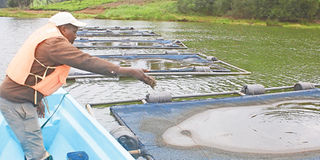Cage fish farming now lands in Nyeri

Kenya has an annual fish deficit of up to 400,000 tonnes.
What you need to know:
- The farmers, with the help of the county government, are running the cage fish farm in Chinga Dam in Othaya.
- The cages are made of plastic rails that hold the nets and measure approximately 15ft and one metre deep and have been placed two metres apart.
- The cages host 10,000 tilapia monosex fish that are due for harvesting in December.
- Kinyua observes that the county is working on an ‘Eat More Fish’ campaign to encourage farmers to keep fish.
For years now, cage fish farming has been a domain of farmers living on the shores of Lake Victoria.
This, however, is no longer the case as a group of farmers in Nyeri adopt the technology to keep fish in the county’s largest dam.
The farmers, with the help of the county government, are running the cage fish farm in Chinga Dam in Othaya.
In this mode of aquaculture, fish is reared in cages in large, deep water bodies like lakes or dams, the natural environment where it normally lives.
The fingerlings are put in metal and plastic cages to protect them from predators while providing them with artificial feeds.
At Chinga Dam, the county government has invested Sh1 million. Ezekiel Wachira, the chairman of Chinga Fishing Group, which consists of 15 members, says they began keeping fish in the dam in April.
“We have 10 cages which we assembled on the side of the dam with the assistance of county government officials and experts.”
The cages are made of plastic rails that hold the nets and measure approximately 15ft and one metre deep and have been placed two metres apart.
“To make the cages float, we have fitted them with at least six empty 20-litre jerricans each. The plastic containers are filled with ballast to anchor the cages on one spot in water.”
“The county pumped in the money as a pilot project and to support us but as a group, we are meeting the cost of feeding the fish,” adds Wachira.
They offer the fish at least 5kg of feeds a day, with a 50kg bag going for Sh2,500.
GREENHOUSE FISH FARMING
The cages host 10,000 tilapia monosex fish that are due for harvesting in December.
Wachira says he is hopeful that the fish will attain the right weight and sell a kilogramme at Sh300.
The dam has its own tilapia and catfish which the group had been fishing for years and sell by the road side.
“Previously, we would spend more than 10 hours to catch a fish in the dam and it was never guaranteed,” says Stephen Kiragu, a member of the group.
But with cage fish, they expect their production to rise, and they will sell the fish to Wamagana Fisheries.
Nyeri agriculture executive Henry Kinyua says the cage culture system will be rolled out in other public dams in the county.
“We are also encouraging greenhouse fish farming which enhances faster growth rate.”
He further stated that in case the county fails to meet the factory capacity of 12 tonnes per week, it will source fish from neighbouring counties.
“The department in collaboration with the national government will buy two monosex fingerling hatcheries which will ensure continuous supply of fingerlings to the farmers,” says Kinyua.
Kinyua observes that the county is working on an ‘Eat More Fish’ campaign to encourage farmers to keep fish.
“We will also be demonstrating different ways to cook fish to enhance the culinary skills of Nyeri women who cite challenges in cooking the delicacy.”
****
Challenges
Diseases to look out for in cages
Fin rot makes both the fish fins and the tail to decay such that the fingerlings or the fish cannot swim.
Bacterial tail and fin rot are common diseases which attack fish reared in both ponds and under the cage system.
Fin rot is associated with polluted and unsanitary conditions in hatcheries.
Though bacteria are the causative agent of tail and fin rot, pathogenic protozoans and fungi may be involved.





